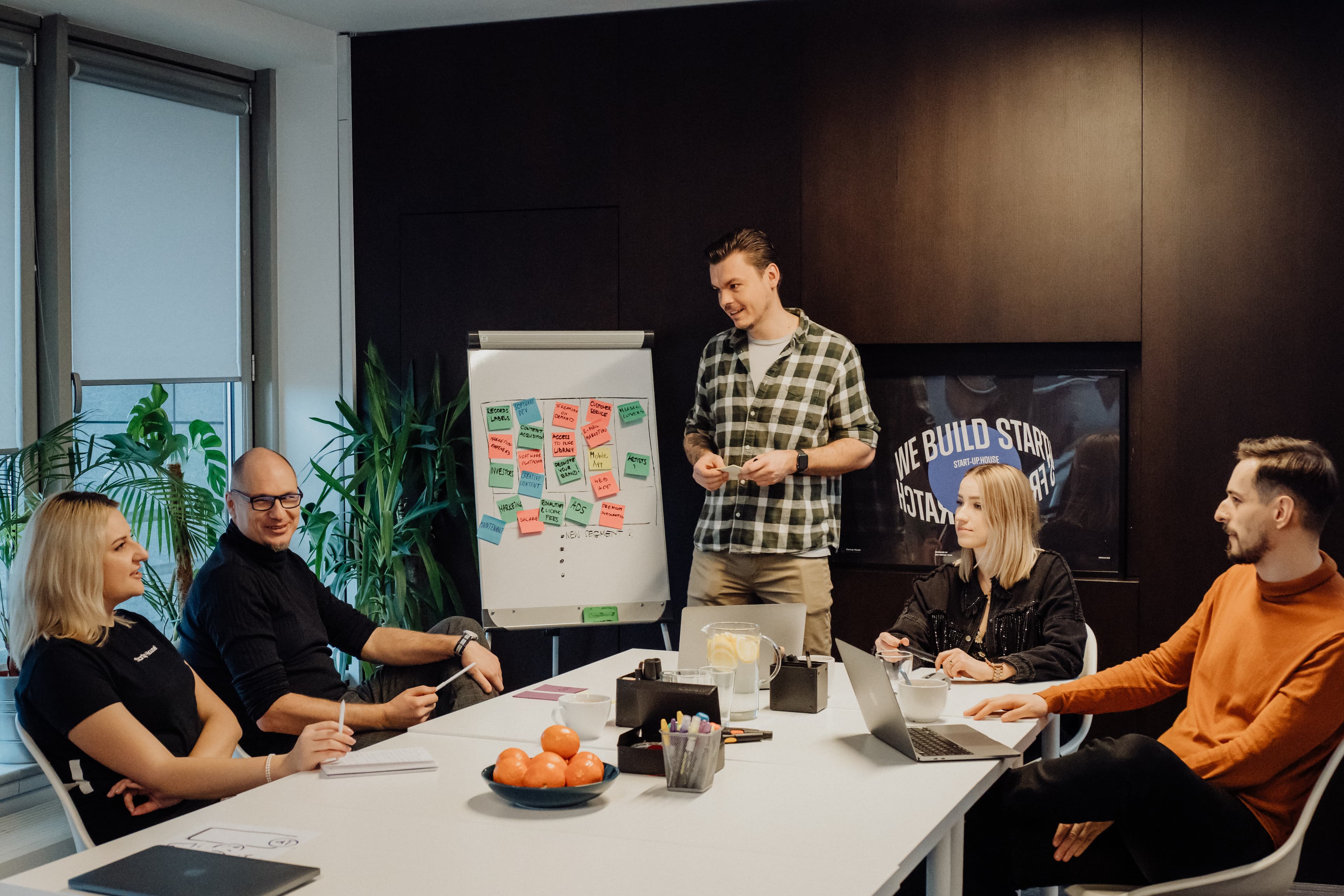What is Digital Transformation in Higher Education?
Marek Pałys
Nov 14, 2022・5 min read
Table of Content
Key Objectives of Digital Transformation in Higher Education
Improving the Student’s Learning Environment
Enhancing the Institution’s Operational Efficacy
Increasing Computing Power for Cutting-Edge Research
Stimulating Innovation in Education
Cutting Costs
Types of eLearning in Higher Education
Fixed eLearning vs. Adaptive eLearning
Asynchronous eLearning vs. Synchronous eLearning
Interactive, Collaborative eLearning vs Individual eLearning
Remote Learning vs. Online Learning
eLearning vs. Digital Learning
MOOC vs. SPOC
Virtual Classes vs. Mobile Learning
Social Learning vs. Adaptive Learning
Examples of Digital Transformation in Higher Education
Virtual Learning
School-wide Apps
Digital Payments
Chatbots in Libraries
Digital Procurement
Online Recruiting
AR/VR
Challenges in Digital Transformation for Higher Education Institutions
Changing Student Requirements
Technological Challenges
Lack of IT Support
Lack of Necessary Skills
Higher Education Digitalization FAQs
Digital transformation in higher education refers to the integration of digital technologies into the academic and operational aspects of colleges and universities. Many institutions have embraced technology shifts, with the objective of improving the teaching and learning experience. By leveraging digital tools, higher education institutions aim to enhance student experience, streamline business processes, and position themselves for continued success in an ever-evolving landscape.
Digital transformation efforts within the higher education sector encompass everything from online courses to the use of augmented reality in classrooms. For instance, the integration of data analytics aids institutions in making data-driven decision-making processes, ensuring resources are optimally allocated.
Key Objectives of Digital Transformation in Higher Education
Improving the Student’s Learning Environment
The primary motivation behind digital transformation in higher education institutions is enhancing the student's experience. With tools like virtual environment simulations, interactive eLearning platforms, and online communities, students get an enriched learning experience beyond the traditional classroom setting.
Enhancing the Institution’s Operational Efficacy
Another significant advantage of digital transformation initiatives is the operational improvements they bring. Higher education institutions can automate many business models and processes, making resource allocation more efficient and delivering quality services to students and staff.
Increasing Computing Power for Cutting-Edge Research
For institutions that conduct research, the need for powerful computing resources is undeniable. With digital investments in areas like artificial intelligence and machine learning, institutions can handle vast amounts of data, making breakthroughs more achievable.
Stimulating Innovation in Education
By embracing emerging technologies and educational technology tools, institutions can foster a culture of innovation. This not only benefits current students but also attracts potential ones, giving the institution a competitive advantage.
Cutting Costs
Digital solutions often lead to streamlined operations, which can result in significant cost savings. By automating certain tasks and leveraging online tools, institutions can reduce overhead costs.
Types of eLearning in Higher Education
Fixed eLearning vs. Adaptive eLearning
While fixed eLearning follows a set curriculum, adaptive learning changes based on the learner's performance, offering a more personalized experience.
Asynchronous eLearning vs. Synchronous eLearning
Asynchronous learning allows students to study at their own pace, while synchronous eLearning necessitates real-time interaction.
Interactive, Collaborative eLearning vs Individual eLearning
Some platforms promote group activities and collaborations, while others are designed for self-paced, individual learning.
Remote Learning vs. Online Learning
Though often used interchangeably, remote learning typically refers to temporary digital teaching methods in situations like pandemics, while online learning is a permanent, structured approach.
eLearning vs. Digital Learning
While eLearning is often confined to formal courses, digital learning encompasses all digital educational interactions, including informal ones.
MOOC vs. SPOC
MOOCs (massive open online courses) are available for a wide audience, often for free. In contrast, SPOCs (small private online courses) are limited to specific groups and often have a fee.
Virtual Classes vs. Mobile Learning
Virtual classes are online courses replicating a classroom setting, while mobile learning is education via smartphones or tablets.
Social Learning vs. Adaptive Learning
Social learning leverages interactions with peers, while adaptive learning adjusts content based on the student’s progress.
Examples of Digital Transformation in Higher Education
Virtual Learning
Higher education institutions now offer complete courses through virtual platforms, granting students flexibility.
School-wide Apps
Institutions are developing their own apps, centralizing services like schedules, announcements, and resources.
Digital Payments
Facilitating fee payments, donations, and other transactions through digital platforms for ease and efficiency.
Chatbots in Libraries
Enhancing student experience by answering common queries without human intervention.
Digital Procurement
Streamlining purchase processes and inventory management using digital tools.
Online Recruiting
Using digital platforms to attract and recruit potential students and staff.
AR/VR
Implementing augmented reality and virtual reality in classrooms to offer immersive learning experiences.
Challenges in Digital Transformation for Higher Education Institutions
Changing Student Requirements
As digital natives enter colleges, their expectations of the institution's digital capabilities are high.
Technological Challenges
Keeping up with the rapidly changing technological landscape can be daunting.
Lack of IT Support
Institutions require a robust IT team to manage and implement digital initiatives.
Lack of Necessary Skills
Faculty might need training in new technologies to effectively use them in teaching.
Higher Education Digitalization FAQs
What is digital transformation in higher education?
It's the integration of digital technologies into academic and operational facets of colleges and universities.
Why is digital transformation essential for higher education?
It improves the student experience, streamlines operations, and ensures institutions remain competitive in the digital age.
How does eLearning differ from digital learning?
While eLearning is confined to formal courses, digital learning includes all digital educational interactions, both formal and informal.
What are MOOCs and SPOCs?
MOOCs are massive open online courses available to a wide audience, often free. SPOCs are small private online courses designed for specific groups.
How is adaptive eLearning beneficial?
Adaptive eLearning offers a personalized experience by adjusting the content based on the learner's performance.
What are the challenges of digital transformation in higher education?
They include changing student requirements, technological advancements, lack of IT support, and the need for skill development among faculty.
How does augmented reality (AR) enhance learning?
AR offers immersive learning experiences by overlaying digital information on the real world.
What is the significance of virtual learning in higher education?
It offers flexibility to students by providing complete courses through virtual platforms.
Why are digital payments important in universities?
They facilitate ease and efficiency in transactions like fee payments and donations.
What is the role of chatbots in digital transformation?
Chatbots enhance the student experience by providing instant answers to common queries without human intervention.
How do school-wide apps benefit institutions?
They centralize services such as schedules, announcements, and resources, making them easily accessible to students and staff.
What's the difference between remote and online learning?
Remote learning is a temporary digital teaching method often due to unforeseen circumstances, while online learning is a structured, permanent approach.
Why is IT support crucial for digital transformation?
A robust IT team is necessary to manage, implement, and maintain digital initiatives effectively.
How do institutions benefit from digital procurement?
Digital procurement streamlines purchase processes and inventory management, resulting in cost savings.
Why is digital recruiting significant?
It uses digital platforms to attract and recruit potential students and staff, expanding the institution's reach.
How do social and adaptive learning differ?
Social learning leverages peer interactions, while adaptive learning adjusts content based on a student’s progress.
What technologies drive digital transformation in higher education?
Infrastructure, cloud computing, data analytics tools, online platforms, and security measures are pivotal.
What's the goal of frameworks in achieving digital transformation?
Frameworks guide institutions through their transformation journey, ensuring a holistic and systematic approach.
How do digital tools improve operational efficacy in institutions?
They automate tasks and processes, making resource allocation more efficient and delivering quality services.
What are the stages of digital transformation in higher education?
Institutions typically progress from digital awareness to literacy, integration, and finally, innovation.
Digital Transformation Strategy for Siemens Finance
Cloud-based platform for Siemens Financial Services in Poland


 Don't miss a beat - subscribe to our newsletter
Don't miss a beat - subscribe to our newsletterYou may also like...

Avoiding Common Pitfalls: A Practical Guide to Digital Transformation for Startups
A practical guide for startups to embrace digital transformation, optimise processes, and achieve sustainable growth.
Alexander Stasiak
Feb 28, 2025・12 min read

Top Traits of an Outstanding Software Development Team
The success of any software project depends on the team. See the top traits that turn good dev teams into outstanding ones.
Alexander Stasiak
Apr 18, 2025・12 min read

Embracing the Future: How Digital Transformation is Changing Customer Experience
Digital transformation is redefining how businesses connect with customers through innovation and technology.
Alexander Stasiak
Apr 21, 2025・16 min read



